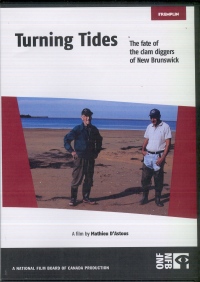| ________________
CM . . . . Volume XVI Number 41. . . .June 25, 2010. 
 |
Turning Tides: The Fate of the Clam Diggers of New Brunswick.
Mathieu d’Astous (Writer & Director). Murielle Rioux-Poirier (Producer). Jacques Turgeon (Executive Producer).
Montreal, PQ: National Film Board of Canada, 2007.
24 min., DVD, $99.95.
Order Number: 153E 9908 307.
Grades 11 and up / Ages 16 and up.
Review by Cathy Vincent-Linderoos.
***/4
|
| |
|

This film shows a story portraying a home-grown industry -- the Eastern New Brunswick clam fishery of Kouchibouguac National Park-- in rapid decline. We see and hear from a range of French-speaking participants and observers, but predominantly it is the Acadian and MicMaq fishermen, themselves, who are watching their time-honoured occupations (as clam fishermen) being severely threatened and ending.
Why are the clam populations sick and dying? Few words are necessary to explain the reasons why the fishery has been so compromised. The film, itself, shows several all-too obvious scenes of environmental pollution, including active sewage outflow pipes spewing non-stop effluent into the ocean, and certain dangerous agricultural spraying practices.
For an accompanying brief on bivalve poisoning in Canada's east coast fisheries, students should start their research at Parks Canada online. The clams, vulnerable creatures in a precarious position, have suffered from commercial over-harvesting as well as the huge impact from the reckless treatment of their inter-connected physical environment. Viewers can only wince as they watch a fisherman and a local recreational fisherman each eat a raw clam whole. These are waters where the fecal-coliform level is all-important because it is apparently a world where untreated sewage is dumped. Humans beware!
It would take a resourceful teacher with a determined group of students some time to determine to what degree the fishery's environment has been improved by the various measures taken by the government. It is one-thing to keep track of the location, size and age-distribution of the clam population, but it is another to actually see improvement from eradicating the significant problems that have caused the serious disruption we see.
I am impressed by the amount of information presented in this important documentary. It would be an excellent film to show to a Grade 11 or 12 Biology or to an upper-school French class. While politics are mostly invisible in the film, it is a film where there's obviously more to an unfolding story. Perhaps one could devise a way to ask the university aquaculture biologists in the Maritimes what they think about politics, the environment and clam fisheries. Is there ''room'' for both clams and tourists at Kouchibouguac?
Those who live elsewhere in Canada have serious water-pollution issues, too. None of us can afford to be complacent.
Recommended.
Cathy Vincent-Linderoos is a retired science teacher who lives in London, ON.

To comment on this title or this review, send mail to
cm@umanitoba.ca.
Copyright © the Manitoba Library Association. Reproduction for personal use is permitted only if this copyright notice is maintained. Any other reproduction is prohibited without permission.
NEXT REVIEW |
TABLE OF CONTENTS FOR THIS ISSUE- June 25, 2010.
AUTHORS |
TITLES |
MEDIA REVIEWS |
PROFILES |
BACK ISSUES |
SEARCH |
CMARCHIVE |
HOME |
